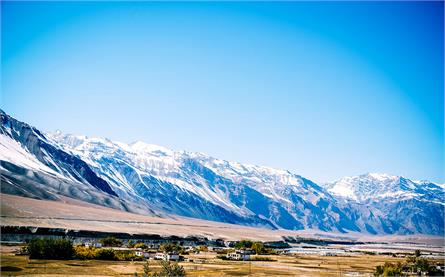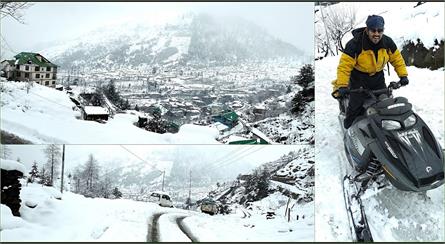An Enchanting Journey to Leh
"Let Leh unveil its magic as you embark on a transformative adventure in this enchanting land."
Nestled amidst the towering peaks of the Himalayas, Leh is a destination that defies the ordinary and immerses you in an extraordinary realm of beauty and spirituality. As you venture into this remote region of Ladakh, you'll be captivated by its surreal landscapes and awe-inspiring vistas. The rugged terrains adorned with barren mountains, deep valleys, and shimmering lakes create a dramatic backdrop that leaves you spellbound.
Leh's charm lies not only in its natural grandeur but also in its rich cultural heritage. The city is home to ancient monasteries, each housing precious relics resonating with centuries-old traditions. The air is filled with tranquillity as you witness Buddhist monks performing their rituals and locals going about their daily lives with serene grace.
Beyond the stunning landscapes and spiritual allure, Leh offers thrilling adventures for brave souls. From trekking through the breathtaking Zanskar and Ladakh ranges to conquering the world's highest motorable passes and nature enthusiasts alike.
Also Read: Ladakh The Place of Adventure
History of Leh
Enveloped within the mystique of the Himalayas, Leh has a history as captivating as its picturesque landscapes. The history dates back thousands of years; this ancient city has been a cultural exchange, trade, and spiritual pilgrimage hub. It was a vital stop on the historic Silk Road, connecting the Indian subcontinent with Central Asia and Europe. Over the centuries, Leh has witnessed the rise and fall of empires, from the mighty Tibetan kingdoms to the Mughals and the Dogras. Each dynasty has left its indelible mark, evident in the grand palaces, monasteries, and traditional architecture that grace the city. Today, Leh stands as a testament to its glorious past, beckoning visitors to delve into its rich tapestry of history, where tales of conquerors, explorers, and saints intertwine to create a fascinating narrative that echoes through time.
Also Read: Kullu Manali
Weather Report of Leh
Leh experiences extreme and challenging climatic conditions that can pose risks to residents and visitors. One of the most dangerous conditions in Leh is the severe cold, with temperatures plunging well below freezing, sometimes reaching -30 degrees Celsius (-22 degrees Fahrenheit). This extreme cold can lead to frostbite, hypothermia, and hypothermia.
Due to its high altitude, another hazardous climate condition in Leh is the thin air and low oxygen levels. Low oxygen levels can cause altitude sickness, ranging from mild discomfort to potentially life-threatening conditions such as high-altitude pulmonary edema (HAPE) or high-altitude cerebral edema (HACE).
Additionally, Leh is susceptible to occasional flash floods and landslides during the monsoon season. The sudden surge of water and debris can be hazardous, causing road blockages and infrastructure damage and posing risks to personal safety.
Also Read: Solang Valley
Best Time to visit
1. Summer (June to September): The weather is pleasant, with temperatures ranging from 15°C to 30°C during the day. Nights can be chilly, with temperatures dropping to 5°C or below.
The best time to visit Leh is during the summer, from May to September, with weather and clear skies. This period is ideal for sightseeing, trekking, and adventure. Leh experiences extreme weather conditions, so it's essential to plan your visit:
The weather in Leh can be pretty unpredictable, even during the summer. However, this is generally the safest and most accessible time to visit, as the roads and mountain passes are open, allowing for smooth travel and exploration of the region.
2. Winter (October to May): Leh witnesses freezing temperatures, often dropping below -20°C. Heavy snowfall occurs, making certain areas inaccessible. Only a few hotels and guesthouses remain open during this period.
It's advisable to avoid visiting Leh during the winter months (October to April) due to frigid temperatures, heavy snowfall, and the closure of most mountain passes. The harsh winter conditions make it challenging to navigate the region and restrict outdoor activities.
To make the most of your visit to Leh, plan your trip during the summer season when the weather is favourable, and ensure you check the local weather forecasts and road conditions before your journey.
Best Places to Visit in Leh
Prepare to be enchanted by the warmth and hospitality of the Ladakhi people as you immerse yourself in the vibrant markets, savour the flavours of local cuisine, and embark on soul-stirring journeys to ancient palaces and remote villages.
In Leh, time seems to stand still, allowing you to disconnect from the world's chaos and reconnect with your inner self amidst the harmonious blend of nature, spirituality, and culture as timeless as the mountains. Here are the best places to visit in Leh.
1. Pangong Tso: Marvel at the ethereal beauty of this serene lake, its azure waters reflecting the surrounding mountains, creating a mesmerising spectacle.
2. Nubra Valley: Journey through breathtaking dunes, encounter double-humped camels, and explore ancient monasteries in this enchanting valley.
3. Hemis Monastery: Immerse yourself in the spiritual ambience of one of Ladakh's most significant monasteries, known for its grandeur and religious festivals.
4. Thiksey Monastery: Admire the intricate architecture and the 15-meter-high Maitreya Buddha statue while soaking in the peaceful atmosphere of this revered monastery.
5. Leh Palace: Experience the regal charm of Leh Palace, an architectural marvel that offers panoramic views of the city and surrounding mountains.
Accommodation Options in Leh
1. Luxury Hotels and Resorts: Indulge in lavish comforts and world-class amenities by renowned hotels and resorts like The Grand Dragon, The Zen Ladakh, and The Druk Ladakh.
2. Guesthouses and Homestays: Immerse yourself in the local culture and hospitality by opting for guesthouses and homestays, such as the Saboo Resorts and Reeyork Guest House.
3. Camping: For adventure enthusiasts, camping under the starry Ladakhi skies is a unique experience. Numerous camping sites, like the Hunder Sand Dunes and Pangong Tso, offer an unforgettable stay close to nature.
How To Reach
Reaching Leh, a remote location in the Himalayas, requires careful planning and considering transportation options. Here's a general guide on how to reach Leh from various places:
1. By Air
The easiest and most convenient way to reach Leh is by air. Kushok Bakula Rimpochee Airport in Leh is well-connected to major cities in India, including Delhi, Mumbai, and Srinagar. Several airlines operate regular flights to Leh during the summer when the weather permits.
2. By Road
From Srinagar: The National Highway 1 (NH1) connects Srinagar to Leh. The road journey takes approximately two days, passing through picturesque landscapes and high mountain passes like Zoji La and Fotu La. This route is open from May to October, depending on weather conditions.
From Manali: The Leh-Manali Highway is a popular route for reaching Leh by road. This scenic route passes through high-altitude desert terrain and crosses the famous Rohtang Pass and Tanglang La. The road remains accessible from June to September.
From Jammu: You can also reach Leh by road from Jammu, but it's a longer and more challenging journey. The Jammu-Srinagar-Leh route covers approximately 1,000 kilometres (620 miles) and requires careful planning and multiple stops.
It's important to note that road journeys to Leh involve travelling through high-altitude regions, and altitude sickness can be a concern. Acclimatizing appropriately, taking necessary breaks, and carrying essential medications are advisable.
3. By Bus
The Jammu and Kashmir State Road Transport Corporation (JKSRTC) operates regular bus services from Srinagar and Manali to Leh during summer. These bus services offer an economical option for reaching Leh, but the journey can be long and arduous.
Check the current road conditions, weather updates, and any necessary permits required for your chosen route before embarking on your journey to Leh. Additionally, booking flights or making travel arrangements in advance, especially during the peak tourist season, is advisable to ensure availability and a smooth travel experience.
Precautions for a Safe Journey
1. Acclimatization: Leh's high altitude requires acclimatisation. Spend the first few days in Leh to adjust before venturing to higher altitudes.
2. Stay Hydrated: Drink plenty of fluids to combat the dry climate and prevent altitude sickness. Carry a water bottle and avoid excessive caffeine and alcohol.
3. Sun Protection: Leh experiences intense UV radiation due to high altitudes. Wear sunscreen, hats, sunglasses, and protective clothing to safeguard yourself from sunburn.
4. Dress Appropriately: Pack warm clothing, including jackets, thermals, and woollens, even during summer. Layering is essential to adapt to temperature variations.
5. Respect Local Customs: Leh is deeply rooted in Tibetan Buddhist culture. Respect local customs, traditions, and monasteries by following dress codes, removing shoes when required, and maintaining decorum during religious ceremonies.
Some essential things you must know
If you're planning a trip to Leh, here are some essential things that tourists should know before embarking on their journey. Remember to do thorough research, plan your itinerary well in advance, and be prepared for a unique and adventurous experience in the breathtaking landscapes of Leh.
1. Permits
Certain areas in Leh, especially near the border regions, require inner-line tourist permits. Make sure to check the latest permit requirements and obtain them before your trip.
2. Altitude sickness
Leh is located at a high altitude, ranging from 9,800 feet to over 17,000 feet above sea level. It's essential to acclimatise appropriately to avoid altitude sickness. Plan your itinerary in a way that allows for gradual ascent and takes enough time to rest and hydrate.
3. Weather conditions
Leh experiences extreme weather conditions, with freezing temperatures in winter and cool summers. Pack appropriate clothing, including layers, warm jackets, hats, gloves, and sturdy footwear. Be prepared for temperature fluctuations during the day and night.
4. Road conditions
The journey to Leh involves traversing challenging terrains and high mountain passes. Roads may be bumpy and narrow, and altitude sickness can affect driving. Hiring an experienced local driver or using a reputable tour operator is recommended.
5. Health and safety
Carry essential medications, a basic first aid kit, and water purification tablets. Stay hydrated and avoid consuming untreated water. Use sunscreen and sunglasses to protect yourself from the harsh sun at high altitudes. It's also advisable to have travel insurance that covers emergency medical evacuation.
6. Accommodation and amenities
Accommodation options in Leh range from luxury hotels to guesthouses and homestays. However, it's important to note that the region is relatively remote, and amenities may be limited compared to urban areas. Plan your accommodations, especially during peak tourist seasons.
7. Respect local culture
Leh has a rich cultural heritage with predominantly Tibetan Buddhist influences. Respect local customs, traditions, and religious sites. Dress modestly, especially while visiting monasteries and other holy sites. Seek permission before taking photographs.
8. Environmental Conservation
Leh is a fragile ecosystem, and responsible tourism is essential to preserve its natural beauty. Respect the environment, avoid littering, and follow sustainable travel practices. Avoid using single-use plastics and opt for eco-friendly alternatives.
9. Connectivity and communication
In some areas, mobile network coverage in Leh can be limited and erratic. Be prepared for intermittent connectivity and carry a local SIM card from a reputable provider. Inform your family and friends about your itinerary, and keep emergency contact numbers handy.
10. Plan for remote areas
Some areas in Leh, such as Pangong Tso and Nubra Valley, are relatively remote and need more facilities. Plan your trips accordingly, carry enough food, water, and fuel, and be prepared for minimal access to ATMs, fuel stations, and medical facilities.











